Which Muti-Factor Authentication (MFA) method is best?
7th August 2025
With passwords alone unreliable, how can another step ensure added security (and which method is best)?
It is becoming increasingly apparent that passwords are not a reliable method of cyber security. True, they are preferable to no security at all, and if used correctly they difficult to guess, but our laziness results in repeated passwords which means every account is at risk.
Before passkeys become implemented in more places, it is worth considering what can be done to improve account security: this is where MFA comes in. This extra step adds an additional layer of protection – but which type of MFA is best? Take a look at our list and see which method would work best for you:
SMS Codes
This is when a one-time code is sent to your phone via text when you try to access your account.
While it is widely available and easy to use, it provides the least amount of security, as it is vulnerable to interception or phishing. Still, better than nothing!
Biometric Authentication
This refers to the use of a unique biological identifier – fingerprint, facial scan or iris pattern – to identify the user, like Face ID. It is very convenient as there is no need to remember anything, and it is quick to use.
Occasionally it can be spoofed, but it is rare, although some have concerns over privacy when it comes to biometrics (and it isn’t as widely available).
Push Notification-Based MFA
When you attempt to sign in to your account, a notification is sent to your phone asking you to either approve or deny to the access. It is very easy to use and widely available.
It is very secure but sometimes approval can be given out of habit by accident, which can lead to a breach. Furthermore, internet access is required for it to work, reducing usability for some.
Authenticator Apps
These are mobile apps – Google or Microsoft Authenticator might be the most popular examples – that generate codes that refresh. To access, you need to enter the code from your phone, and it refreshes every 30 seconds. They are resistant to phishing and don’t rely on SMS.
While these are more complex to setup, you only need to do so once. You need access to a mobile device, and vulnerabilities can arise if the phone is lost.
Hardware Security Keys
These are physical devices you can use, like a USB stick or NFC token, that you can plug in or tap to authenticate. They are immune to phishing, man-in-the-middle attacks and SIM swapping. With no reliance on mobile networks and no connection available unless interacting with a device, this method is the most secure.
However, the key can still be lost or forgotten, so, as always, there is room for human error. Also, it may be costly for some businesses and is more complicated to establish than other methods.
It doesn’t really matter what MFA type you choose – it will depend on your needs, budget and technical knowledge – but it is important to select one, to keep your private data secure. If you would like any help implementing MFA, please contact Interfuture Security.
YouTube: https://youtu.be/4JrvbgnbQFg
